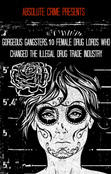Gorgeous Gangsters: 10 Female Drug Lords Who Changed the Illegal Drug Trade Industry

When people think about the drug trade, they think about people like Pablo Escobar and Manuel Noriega...men. Men may rule the world of illegal drug trade, but it's women drug traffickers that will put shivers down your spine. They're beautiful, cunning...and ruthless.
This book of 10 short profiles takes you inside the lives of the most sinister drug lords who ever lived. Inside you’ll learn how they came to power and their gritty tactics of business.
This book of 10 short profiles takes you inside the lives of the most sinister drug lords who ever lived. Inside you’ll learn how they came to power and their gritty tactics of business.
Buy Now!
Gorgeous Gangsters PDF and ePub |
Excerpt
Introduction
Women are achieving fame, fortune, and success in many traditionally male dominated fields these days. That success even extends to the world of drug trafficking, where several narco queens, or female drug lords, have achieved infamy in recent decades.
These women took a number of different routes in their rise to break through the glass ceiling of crime. Some of them, such as Tijuana’s Enedina Arellano Felix, took over the family business when male relatives went to jail. Others, like the godmother of cocaine, Griselda Blanco, built up the business on their own.
Observers have noted that women’s roles in the drug trade mirror that in other areas of Latin American culture. In some Latin American countries such as Mexico, women traditionally manage the money and run businesses. Many drug cartels, including Mexico’s Felix Organization, or Gulf Cartel, let women run the money side of the business.
Controlling the money lets the narco queens run the cartels and lets them finance lavish lifestyles in high society. That, of course, can backfire, as Guatemalan Marllory Dadiana Chacón Rossell found out; living large attracts attention from the media and from authorities. Chacon was named an official Kingpin by the U.S. treasury department and had legal restrictions placed on her business activities.
A more recent trend has been the appearance of female soldiers on the front lines of Mexico’s drug wars. One cartel, Los Zetas, has even let female soldiers assume traditionally male roles such as heading hit squads and managing drug traffic on the streets.
Equal opportunity has come to the drug trade and given rise to many colorful narco queens. As the drug trade expands, many more narco queens will appear in coming years.
Taking Over the Family Business: Estrella Ramos There are several routes that young women take in order to achieve the position of narco queen. Some are self-made criminal entrepreneurs like Griselda Blanco and Kath Pettingill. Others rise through the ranks of drug syndicates, but many simply inherit or take over the “family business.” That is definitely the case with Estrella Ramos of Mazatlan.
Ramos was exposed to the drug trade and the money and power that come with it at a very early age. Her father Juan, or “Johnny,” Ramos was a police officer who moonlighted as a smuggler for the Sinaloa cartel. As a girl, Estrella knew that her family had far more money than other middle class Mexicans in the neighborhood.
The money came from shipments of drugs that her parents Johnny and Acela Ramos would haul to the border between Mexico and Texas in a trailer. Once in the states of Nueva Leon, Coahuila, and Chihuahua, the drugs would be sold to other smugglers that would move them into the USA. Ramos was a middleman in the drug trade, moving cocaine landed at the port of Mazatlan to a point of access to the main market: the United States.
A Middle Class Family Despite their involvement in the drug trade, the Ramos’ were a middle class family; Johnny was a police officer and Acela was a school teacher. Yet they were also a middle class family that kept caches of drugs and weapons in their home and had numerous late night visitors calling at their homes. The visitors were members of the Sinaloa cartel who came to buy and sell drugs.
One room in their home that Johnny and Acela wouldn’t let little Estrella play in contained an arsenal of high-powered rifles. That room was also her parents’ bedroom. The money and influence that drugs bought came with an extremely high price.
Despite their involvement in a violent criminal activity, the Ramos’ kept their middle class values; they forced Estrella to study hard and get good grades so she could get into college. The Ramos’, it seemed, wanted Estrella to rise in the world and get out of the drug trade. Their criminal activities were designed to advance their family’s social and economic status.
Johnny Ramos Destroys Himself Like many people that turned to crime to advance their social and economic status, Johnny Ramos eventually destroyed himself. The drugs and money went to his head, and Ramos began acting more and more like a drug dealer and less and less like a family man.
Johnny started using cocaine and having affairs with other women. He started openly cavorting around town with his mistress and took the other woman on lavish shopping sprees. When his cop’s salary and drug business couldn’t finance the extravagant lifestyle, Ramos began borrowing money from his friends in the cartel.
Acela soon tired of her husband’s antics and walked out on Johnny. Yet at the same time her marriage was breaking up, Acela forced Estrella into a socially acceptable marriage with the owner of a shrimp factory.
The marriage itself might have been designed to protect the family’s reputation. Estrella gave birth to a daughter shortly after the nuptials, which indicates that she may have been pregnant before the wedding. Her parents might have forced her into the marriage to avoid the stigma of having an illegitimate grandchild.
Johnny Gets Gunned Down Johnny Ramos met his end just like the stereotypical cocaine cowboy that he had become. He died in a hail of gunfire while sitting in a car outside a bodega in 2001. One of the first people to see Johnny was Estrella, who ran to the scene. She got there in time to see paramedics taking her father’s body away.
The reasons for Johnny’s death are still unclear. He might have been killed by rival traffickers, such as the trigger happy and militaristic Los Zetas who were beginning their rise to the top of Mexico’s drug trade at the turn of the century. Ramos may have also fallen prey to loan sharks or been eliminated by the cartel because his wild ways were interfering with business.
Ramos’ death propelled Estrella to enter the drug trade because she was now in a terrible position. Acela and Estrella were now liable for Johnny’s debts to the cartel. To make matters worse, Estrella was now a recently divorced, single mother with a young daughter to support. If they wanted to maintain their lavish lifestyle, mother and daughter would have to go into the drug business.
Women are achieving fame, fortune, and success in many traditionally male dominated fields these days. That success even extends to the world of drug trafficking, where several narco queens, or female drug lords, have achieved infamy in recent decades.
These women took a number of different routes in their rise to break through the glass ceiling of crime. Some of them, such as Tijuana’s Enedina Arellano Felix, took over the family business when male relatives went to jail. Others, like the godmother of cocaine, Griselda Blanco, built up the business on their own.
Observers have noted that women’s roles in the drug trade mirror that in other areas of Latin American culture. In some Latin American countries such as Mexico, women traditionally manage the money and run businesses. Many drug cartels, including Mexico’s Felix Organization, or Gulf Cartel, let women run the money side of the business.
Controlling the money lets the narco queens run the cartels and lets them finance lavish lifestyles in high society. That, of course, can backfire, as Guatemalan Marllory Dadiana Chacón Rossell found out; living large attracts attention from the media and from authorities. Chacon was named an official Kingpin by the U.S. treasury department and had legal restrictions placed on her business activities.
A more recent trend has been the appearance of female soldiers on the front lines of Mexico’s drug wars. One cartel, Los Zetas, has even let female soldiers assume traditionally male roles such as heading hit squads and managing drug traffic on the streets.
Equal opportunity has come to the drug trade and given rise to many colorful narco queens. As the drug trade expands, many more narco queens will appear in coming years.
Taking Over the Family Business: Estrella Ramos There are several routes that young women take in order to achieve the position of narco queen. Some are self-made criminal entrepreneurs like Griselda Blanco and Kath Pettingill. Others rise through the ranks of drug syndicates, but many simply inherit or take over the “family business.” That is definitely the case with Estrella Ramos of Mazatlan.
Ramos was exposed to the drug trade and the money and power that come with it at a very early age. Her father Juan, or “Johnny,” Ramos was a police officer who moonlighted as a smuggler for the Sinaloa cartel. As a girl, Estrella knew that her family had far more money than other middle class Mexicans in the neighborhood.
The money came from shipments of drugs that her parents Johnny and Acela Ramos would haul to the border between Mexico and Texas in a trailer. Once in the states of Nueva Leon, Coahuila, and Chihuahua, the drugs would be sold to other smugglers that would move them into the USA. Ramos was a middleman in the drug trade, moving cocaine landed at the port of Mazatlan to a point of access to the main market: the United States.
A Middle Class Family Despite their involvement in the drug trade, the Ramos’ were a middle class family; Johnny was a police officer and Acela was a school teacher. Yet they were also a middle class family that kept caches of drugs and weapons in their home and had numerous late night visitors calling at their homes. The visitors were members of the Sinaloa cartel who came to buy and sell drugs.
One room in their home that Johnny and Acela wouldn’t let little Estrella play in contained an arsenal of high-powered rifles. That room was also her parents’ bedroom. The money and influence that drugs bought came with an extremely high price.
Despite their involvement in a violent criminal activity, the Ramos’ kept their middle class values; they forced Estrella to study hard and get good grades so she could get into college. The Ramos’, it seemed, wanted Estrella to rise in the world and get out of the drug trade. Their criminal activities were designed to advance their family’s social and economic status.
Johnny Ramos Destroys Himself Like many people that turned to crime to advance their social and economic status, Johnny Ramos eventually destroyed himself. The drugs and money went to his head, and Ramos began acting more and more like a drug dealer and less and less like a family man.
Johnny started using cocaine and having affairs with other women. He started openly cavorting around town with his mistress and took the other woman on lavish shopping sprees. When his cop’s salary and drug business couldn’t finance the extravagant lifestyle, Ramos began borrowing money from his friends in the cartel.
Acela soon tired of her husband’s antics and walked out on Johnny. Yet at the same time her marriage was breaking up, Acela forced Estrella into a socially acceptable marriage with the owner of a shrimp factory.
The marriage itself might have been designed to protect the family’s reputation. Estrella gave birth to a daughter shortly after the nuptials, which indicates that she may have been pregnant before the wedding. Her parents might have forced her into the marriage to avoid the stigma of having an illegitimate grandchild.
Johnny Gets Gunned Down Johnny Ramos met his end just like the stereotypical cocaine cowboy that he had become. He died in a hail of gunfire while sitting in a car outside a bodega in 2001. One of the first people to see Johnny was Estrella, who ran to the scene. She got there in time to see paramedics taking her father’s body away.
The reasons for Johnny’s death are still unclear. He might have been killed by rival traffickers, such as the trigger happy and militaristic Los Zetas who were beginning their rise to the top of Mexico’s drug trade at the turn of the century. Ramos may have also fallen prey to loan sharks or been eliminated by the cartel because his wild ways were interfering with business.
Ramos’ death propelled Estrella to enter the drug trade because she was now in a terrible position. Acela and Estrella were now liable for Johnny’s debts to the cartel. To make matters worse, Estrella was now a recently divorced, single mother with a young daughter to support. If they wanted to maintain their lavish lifestyle, mother and daughter would have to go into the drug business.








